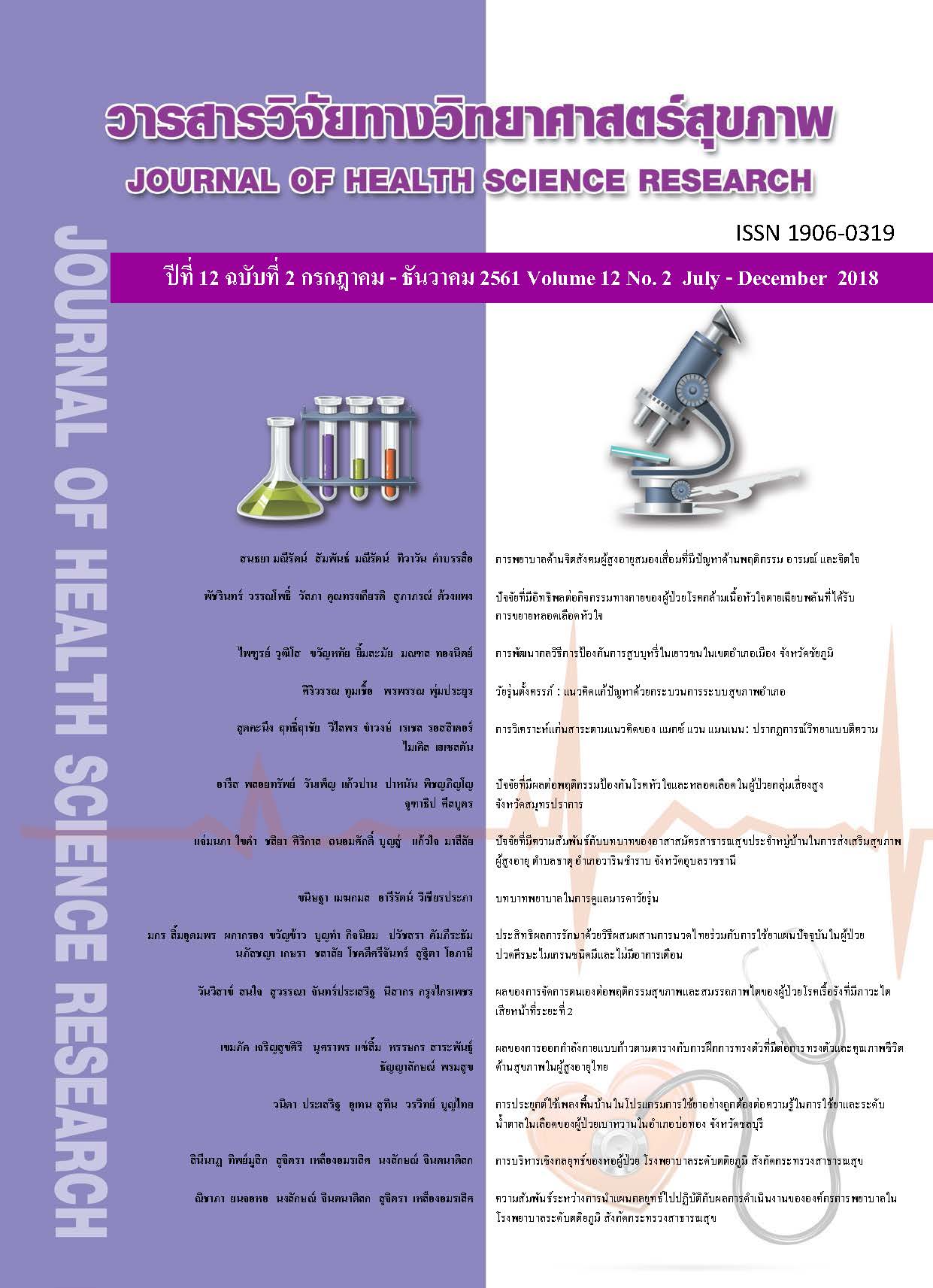Factors influencing physical activity among patients with Acute Myocardial Infarction receiving Percutaneous Coronary Intervention
Main Article Content
Abstract
Physical activity after receiving Percutaneous Coronary Intervention is very important to prevent recurrent myocardial infarction. This correlation predictive research aimed to determine factors influencing physical activity among patients with Acute Myocardial Infarction (AMI) after receiving Percutaneous Coronary Intervention, including severity of disease, health literacy, self-efficacy, and social support. A simple random sampling was used to recruit a sample of 89 AMI patients who received follow-up treatment at Outpatient Department of Internal Medicine, Prapokklao hospital in Chanthaburi province. Data were collected from August to October 2017. Research instruments were self-report questionnaires including questionnaires of health literacy, self-efficacy perception, social support, and physical activity. Their reliability of Cronbach’s Alpha were .82, .85, .71, and .81, respectively. Descriptive statistics and Stepwise multiple regression analysis were used to analyze data.
The results revealed that the severity of disease was the most influencing on the physical activity (β = .562), and the followings were social support (β = .230) and self-efficacy (β = .196) These three factors have influenced and together accounted for 55.0 % in the prediction of physical activity among AMI patients after receiving Percutaneous Coronary Intervention (R2 = .550, F= 34.606, p < .001)
The findings from this study could be evidence to develop physical activity programs by emphasizing social support and self-efficacy.
Downloads
Article Details
บทความที่ได้รับการตีพิมพ์เป็นลิขสิทธิ์ของวิทยาลัยพยาบาลบรมราชชนนี จังหวัดนนทบุรี
ข้อความที่ปรากฏในบทความแต่ละเรื่องในวารสารวิชาการเล่มนี้เป็นความคิดเห็นส่วนตัวของผู้เขียนแต่ละท่านไม่เกี่ยวข้องกับวิทยาลัยพยาบาลบรมราชชนนี จังหวัดนนทบุรี และคณาจารย์ท่านอื่น ในวิทยาลัยฯ แต่อย่างใด ความรับผิดชอบองค์ประกอบทั้งหมดของบทความแต่ละเรื่องเป็นของผู้เขียนแต่ละท่าน หากมีความผิดพลาดใด ๆ ผู้เขียนแต่ละท่านจะรับผิดชอบบทความของตนเองแต่ผู้เดียว
References
2.International Health Policy Program, Ministry of Health. Disease situation report NCDs No. 2 “kick off to the goals” [Internet]. 2016 [cited 2017 Jan 9]; Available from: http://i-regist.igenco.co.th/web/ dmthai_old/sites/default/files/ncd_nhes_v_2016.pdf. (in Thai).
3. The Heart Association of Thailand under the Royal Patronage of H.M. the King. Guideline for ischemic heart disease 2014. Bangkok: Srimuang Printing; 2014.
4. Budnik M, Opolski G. The assessment of coronary heart disease risk factor correlated with demographic and social data in post-coronary intervention patients in Polish population. Cardiol J. 2015;22(3):276-84.
5. Cajanding RJ. Effects of structured discharge planning program on perceived functional status, cardiac self-efficacy, patient satisfaction, and unexpected hospital revisits among Filipino cardiac patients: A randomized controlled study. J Cardiovasc Nurs. 2017;32(1):67-77.
6.Thanaphatsorn N, Howteerakul N, Sujirarat D, Suwannapong N, Kehasukcharorn W. Incidence and factors associated with instent restenosis in coronary heart disease patients at Chest Disease Institute Nonthaburi Province [Oral Presentation]. In: RSU National Research Conference 2015. 24th April 2015; Thailand. Pathum Thani: Rangsit University; p.201-9. (in Thai).
7.Grady PA, Gough LL. Self-management: A comprehensive approach to management of chronic conditions. Am J Public Health. 2014;24(8):e25-31.
8. Tobin DL, Reynolds RVC, Holroyd KA, Creer TL. Self-management and social learning theory. In: Holroyd KA, Creer TL, editors. Self-management of chronic disease: Handbook of clinical interventions and research. Orlando, NY: Harcourt Brace Jovanovich; 1986. p.29-54.
9. Wattanakitkrileart D. Psychosocial problems in patients with heart and lung disease and nursing care. Journal of Nursing Science. 2009;27(2):22-31. (in Thai).
10.Ritpetch N, Jitpanya C, Chimluang J. Relationships among symptom clusters, self-management, health value, sense of coherence, and health -related quality of life in patients with percutaneous coronary intervention. Princess of Naradhiwas University Journal. 2013;5(1):16-34. (in Thai).
11.World Health Organization. Global Physical Activity Questionnaire (GPAQ): Analysis guide [Internet]. 2016 [cited 2017 Jan 9]; Available from: http://www.who.int/ ncds/surveillance/steps/resources/GPAQ_Analysis_Guide.pdf.
12.Zhao S, Zhang Z, Long Q, Ma Y, Lian X, Yang Y, et al. Association between time of day of sports-related physical activity and the onset of acute myocardial infarction in Chinese population. PLoS One. 2016;11(1):e0146472. doi: 10.1371/journal.pone. 0146472.
13.Taweerat P, Buatee S, Wongpiriyayothar A. The relationships between perception of symptom, perception of physical self-efficacy and physical activity level of patients with coronary disease after discharge from hospital. Research and Development Health System Journal. 2015;8(2):157-64. (in Thai).
14.Nutbeam D. The evolving concept of health literacy. Soc Sci Med. 2008;67(12):2072-8.
15.Faul F, Erdfelder E, Lang AG, Buchner A. G* Power 3: A flexible statistical power analysis program for the social, behavior, and biomedical sciences. Behav Res Methods. 2007;39(2):175-91.
16.Polit DF, Hungler BP. Nursing research: Principle and methods. 6th ed. Philadelphia, PA: Lippincott; 1999.
17.Ishikawa H, Takeuchi T, Yano E. Measuring functional, communicative, and critical health literacy among diabetic patients. Diabetes Care. 2008;31(5):874-9.
18.Maneesriwongul W, Tulathong S, Fennie K P, Williams A. Adherence to antiretroviral medication among HIV-positive patients in Thailand. Journal of Acquired Immune Deficiency Syndromes. 2006;43 Suppl 1:119-22. (in Thai).
19.Buarapha S. Relationships between personal factors, perception of symptoms severity, self-efficacy, social support, and physical activity in patients with chronic heart failure [Thesis]. Bangkok: Chulalongkorn University; 2004. (in Thai).
20.Zimet GD, Dahlem NW, Zimet SG, Farley GK. The multidimensional scale of perceived social support. J Pers Assess. 1988;52(1):30-41.
21.Boonyamalik P. Epidemiology of adolescent suicidal ideation: Roles of perceived life stress, depression symptoms, and substance use [Dissertation]. Baltimore: Johns Hopkins University; 2005.
22.Hlatky MA, Boineau RE, Higginbotham MB, Lee KL, Mark DB, Califf RM, et al. A brief self-administered questionnaire to determine functional capacity (The Duke Activity Status Index). Am J Cardiol. 1989;64(10):651-4.
23.Namphonkrung P. Factors related to exercise behavior in coronary artery disease patients [Thesis]. Bangkok: Chulalongkorn University; 2004. (in Thai).
24.Won MH, Son YJ. Perceived social support and physical activity among patient with coronary artery disease. West J Nurs Res. 2017;39(12):1606-23.

